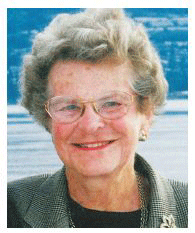Dr Agatha Wilford, 1922–2014

Dr Agatha Wilford (née Tate) was born and raised in Kenora, Ontario. After excelling in high school she attended the Faculty of Medicine at the University of Toronto where she met her husband to be, John Wilford. Following graduation, Agatha and John were married on 22 December 1945 and interned at St. Michael’s Hospital in Toronto. Agatha and John were both officers in the Royal Canadian Army Medical Corps during the Second World War and were discharged in September 1946. Subsequently, they moved to Chilliwack and set up a busy general practice together. Dr Wilford was the first female doctor in Chilliwack. She worked for 8 years before retiring the first time to raise their children. She re-entered general practice in 1972 for another 7 years before retiring for good.
Dr Wilford loved nature, canoeing, gardening, reading, and writing long and newsy letters to her extended family and friends. Agatha and John also loved to travel, with their favorite places being Hawaii and Europe. But her main focus was her family—her children, grandchildren, and great-grandchildren. With her cousin, Dorothy Ostrum Meyerhof, Agatha wrote a history of the Tate family that is in the library of several genealogy societies, including the Archives of Ontario.
Unfortunately, Dr Wilford suffered a stroke in 2001 and had a number of health issues, which she faced with courage and dignity. The last 11 years of her life were spent in the Waverly Seniors Village where she remained a true lady in spite of her challenges. Agatha slipped away peacefully with John, her husband of 68 years, by her side. She is predeceased by her parents, Harry and Gertrude Tate, and her grandson, Johnny Wilford. She is survived by four children, seven grandchildren, one step-grandson, two great-grandchildren, and other extended family.
—Ted Wilford, MD
Nanaimo
